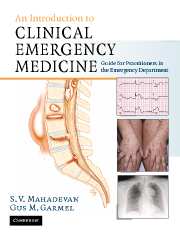Book contents
- Frontmatter
- Contents
- List of contributors
- Foreword
- Acknowledgments
- Dedication
- Section 1 Principles of Emergency Medicine
- Section 2 Primary Complaints
- Section 3 Unique Issues in Emergency Medicine
- Section 4 Appendices
- Appendix A Common emergency procedures
- Appendix B Wound preparation
- Appendix C Laceration repair
- Appendix D Procedural sedation and analgesia
- Appendix E Focused assessment with sonography in trauma
- Appendix F Interpretation of emergency laboratories
- Index
Appendix A - Common emergency procedures
Published online by Cambridge University Press: 27 October 2009
- Frontmatter
- Contents
- List of contributors
- Foreword
- Acknowledgments
- Dedication
- Section 1 Principles of Emergency Medicine
- Section 2 Primary Complaints
- Section 3 Unique Issues in Emergency Medicine
- Section 4 Appendices
- Appendix A Common emergency procedures
- Appendix B Wound preparation
- Appendix C Laceration repair
- Appendix D Procedural sedation and analgesia
- Appendix E Focused assessment with sonography in trauma
- Appendix F Interpretation of emergency laboratories
- Index
Summary
Introduction
Performing procedures in the emergency department is often a challenging process, as such activity may take place under less than ideal conditions. Time may be a consideration, as certain procedures are lifesaving or crucial to a patient's well-being. Circumstances may require that a procedure be performed without undue delay. The need to perform a procedure expeditiously should never lead one to rush the task, though, as the potential for error is magnified by haste. Attention must also always be paid to proper preparation and technique. Some procedures are time-consuming; adequate time should be budgeted for their completion.
Contraindications exist to most of the procedures in this section, and an effort should be made to elicit a patient history of illness or medications being taken that may constitute contraindications or precautions. In the unconscious, intoxicated or uncooperative patient, such medical history may be incomplete or difficult to obtain.
Some of the procedures described need to be performed utilizing sterile technique. It is very important that this be adhered to, because infection is always an undesirable and sometimes dangerous complication. In all instances, also assume that there is a risk of contracting infectious disease by contact with the patient's blood, secretions or other bodily fluids. Utilize precautions to avoid such contact, including gloves, eye protection, masks and surgical gowns, as appropriate.
Be aware what the complications of various procedures are, and assess the patient for signs of their appearance.
- Type
- Chapter
- Information
- An Introduction to Clinical Emergency MedicineGuide for Practitioners in the Emergency Department, pp. 681 - 706Publisher: Cambridge University PressPrint publication year: 2005

